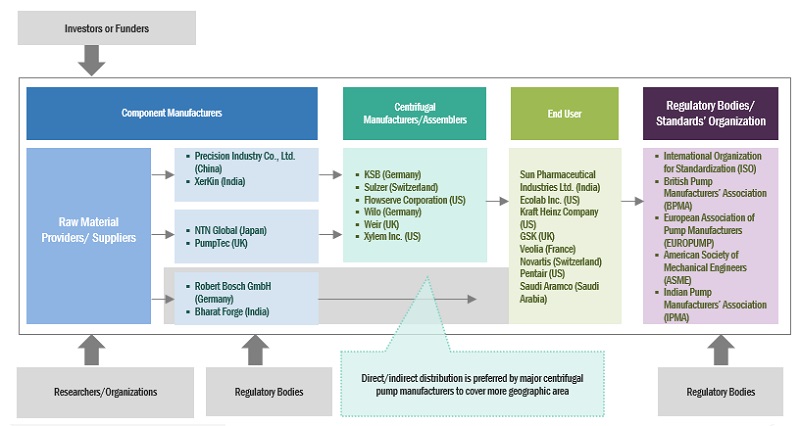Global Centrifugal Pump Market Overview:
The global centrifugal pump market is estimated to grow from USD 39.7 billion in 2023 to USD 51.5 billion by 2028, at a CAGR of 5.4% during the forecast period. The requirement for desalination and water treatment has also contributed to the growth opportunities for centrifugal pump manufacturers. Desalination plants rely on centrifugal pumps for seawater intake, brine circulation, and product water transfer. As water scarcity becomes a pressing issue in many regions, the demand for desalination and water treatment solutions is rising, thereby driving the demand for centrifugal pumps in industrial sector.
Download PDF Brochure: https://www.marketsandmarkets.com/pdfdownloadNew.asp?id=17494785
Based on type, the market has been categorized into overhung impeller, between bearing, and vertically suspended. The market is dominated by overhung impeller type of centrifugal pumps. One common application of overhung impeller centrifugal pumps is in water supply systems for residential and commercial settings. Their compact design makes them a preferred choice in these environments where space is limited. As a result, the overhung impeller segment is projected to dominate the centrifugal pump market during the forecast period, driven by their increased usage in industrial and commercial applications.

Based on operation type, the market has been categorized into below electrical, hydraulic, and air-driven. Within the oil and gas industry, centrifugal pumps serve crucial roles in various applications. They are utilized for main oil line transfer, seawater lifting, effluent treatment, boiler feeds, and more. When it comes to artificial lifts carrying moderate to high fluids from wellbores, electrical centrifugal pumps prove to be efficient and reliable. One significant advantage of these pumps is their ability to prevent the formation of vapor cavities in liquids. They find application in both open-pit and bore well scenarios.
Speak to Analyst: https://www.marketsandmarkets.com/speaktoanalystNew.asp?id=17494785
This report segments the centrifugal pump market based on end user into Based on end user, the centrifugal pump market has been classified into industrial, and residential & commercial. The industrial segment has been further segmented into oil and gas, water and wastewater, mining and metal chemicals, power generation, pharmaceuticals, food & beverage, pulp and paper, agriculture, automotive, and textiles. The industrial segment holds the largest market share of the centrifugal pump market. Centrifugal pumps can handle any kind of debris (stones, sticks, sand, mud, or trash) that can fit through the opening. These are used in feeding filter presses, digestion tanks & thickeners, and pumping stations. They are also used in dosing applications in wastewater treatment processes. The demand for centrifugal pumps in the mining and metals industry is being driven by new infrastructure development projects taking place across the fast-growing economies of Asia Pacific. Such initiatives propel the growth of the centrifugal pump market for the mining and metals industry.
Asia Pacific is the fastest-growing region in the centrifugal pump market. The rising population and resulting increase in electricity demand are anticipated to fuel market growth. The industrial sector has fueled the demand for additional power and is anticipated to expand the market for centrifugal pumps in the power generation industry in the region.
Ask Sample Pages: https://www.marketsandmarkets.com/requestsampleNew.asp?id=17494785
Key Market Players:
The key players in the market include Grundfos Holding A/S (Denmark), Xylem Inc. (US), KSB (Germany), Sulzer (Switzerland), and Flowserve Corporation (US). Strategies such as product launches, partnerships, collaboration, acquisitions, and contracts increase their share in the market. Companies are focussing on manufacturing solar powered centrifugal pumps a new range of pump wherein the pumps utilize solar energy to pump water for irrigation purposes, offering numerous advantages over traditional fuel-based pumps. Farmers can save on fuel expenses and eliminate the dependence on unreliable power grids, making solar water pumps a financially viable and sustainable solution. Furthermore, solar water pumps are environmentally friendly. They produce clean energy, reducing carbon emissions and minimizing the ecological footprint of agricultural activities.


